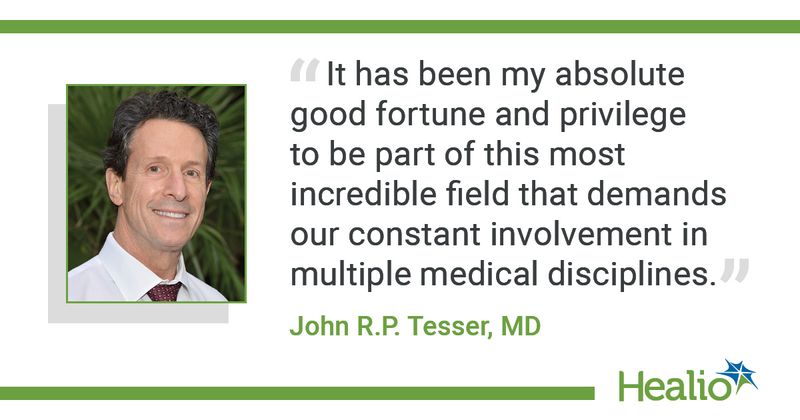Hooked on Rheum with John R.P. Tesser, MD
Searching for a future discipline to pursue during my time in medical school at the University of Rochester in New York, I grappled with family medicine, psychiatry and neurology.
Then, in one of our first-year pathology lectures, Bernard Panner, MD, in a very deadpan voice, told us that we were now going to learn the most important subject in medicine — inflammation. Damn it if he wasn’t right.

Back then, researchers had identified interferon, interleukin-1 and -2, and were zeroing in on interleukin-3 and -6. The year was 1973 and my class friend Eddie Rubin, who was working on his PhD in a combined track, would tell us after hours of his work with his mentor George Abraham, MD. They were fusing myeloma cells with antibody-producing plasma cells. No one could have conceived what fantastic stuff awaited in the future by this look into this amorphous crystal ball.
Lenore Buckley and I shared with two others a cadaver. Lo and behold, both Lenore and I eventually made our way into the field of rheumatology. And much to our years’ later surprise, we realized that four others, out of our class of 80-plus, did the same thing. Who would have dreamed of that? No doubt it was the influence of master clinician, juvenile idiopathic arthritis pediatrician and geriatrician John Baum, MD, and that of division chief John Leddy, MD.
During my internal medicine training at Maricopa County Hospital, in Phoenix, I saw an array of severely affected patients with systemic lupus erythematosus and rheumatoid arthritis, and the field took on an aura of mystery and fascination that demanded an ever-increasing grasp of immunology, yet never strayed from the basic art of physical diagnosis. We still must see and touch to truly appreciate the whole patient. And in those days, we were examining too many patients in stretchers in the halls of the clinic and in wheelchairs.
During my last few months at Maricopa, and while driving back from a camping trip in the Colorado San Juan Mountains, I saw an ad in the New England Journal of Medicine for a fellowship opening at the Bowman Gray Center for Medical Education, at Wake Forest University, in Winston Salem, North Carolina. The next week, I was interviewing and was offered a position immediately. Off I went to North Carolina to dive headfirst into rheumatology, and to meet Michael Weinblatt, MD, fresh out of his fellowship in Boston.
When Michael and the division chief didn’t see eye-to-eye on his investigating methotrexate for RA, he packed up his bags after a year and returned to Boston. However, even then, he was a tremendous teacher and clinician. After he left, well, the rest is history, as we experienced the forces pushing methotrexate to become the gold standard therapy for RA that supplanted the use of intramuscular gold and penicillamine, vestiges of the pre-biologic era of rheumatology.
Immediately after my fellowship, I accepted an offer from Maricopa Medical Center to join their teaching faculty and to take the position of chief of rheumatology, which I held for 10 years until 1992. The chief of our large, multispecialty internal medicine group referred to the infectious disease, endocrinology and rheumatology divisions as the “tin cup divisions.” With Oscar Gluck, MD, and Eric Gall, MD, the chief of rheumatology at the University of Arizona in Tucson, we ran a fellowship training program for several years between the University of Arizona in Tucson and Phoenix until our funding ran out.
After Maricopa, I joined Oscar full-time in practice. We initiated a strong headwind into the field of clinical trials and research. At that time, the focus was all on novel and new NSAIDs, which bears little to no interest in our field these days.
In the 1980s and into the 1990s, we all lamented at American College of Rheumatology meetings that there were no new developments outside of small molecules and the advent of leflunomide. Oscar had a strong training in osteoporosis and metabolic bone disease at Washington University, and he and I ventured into that world by purchasing the seventh Lunar dual energy nucleoside absorptiometer in the mid-1980s. We soon entered the new age of osteoporosis diagnostics and therapeutics with our participation in the alendronate clinical trials, using the newly developed DXA technology in the early 1990s.
However, it was through the ‘90s that things were clearly brewing — in large vats specifically — as we were asked to participate in an ever-increasing number of biologic trials. The years 1998 and 1999 were seminal as they separated rheumatology into the pre-biologic — those who are old enough to have experienced it — and post-biologic eras. What a spectacular run it has been.
I joined Arizona Arthritis & Rheumatology Associates, which has been a tremendous experience as we organically grew and organized our 16 rheumatologists into teams with 36 advanced practice clinicians, to deliver the most cutting edge and efficient care we can give to our patients. Our collective clinical trials experience has allowed me to have participated in the development of every single new molecule and biologic and osteoporosis medicine that has been approved by the FDA over the last 40 years.
It has been my absolute good fortune and privilege to be part of this most incredible field that demands our constant involvement in multiple medical disciplines. Also, what a dramatic decline in the ratio of wheelchairs to offices from pre- to post-biologic era. It offers a bit of a jolt to know that even our internal medicine colleagues think of us as the internists’ internists. After all, when the problem is too esoteric or elusive, who else are they going to call?
John R.P. Tesser, MD
Rheumatologist, Arizona Arthritis & Rheumatology Associates
Clinical lecturer, University of Arizona Health Sciences Center
Adjunct assistant professor of medicine, Midwestern University

